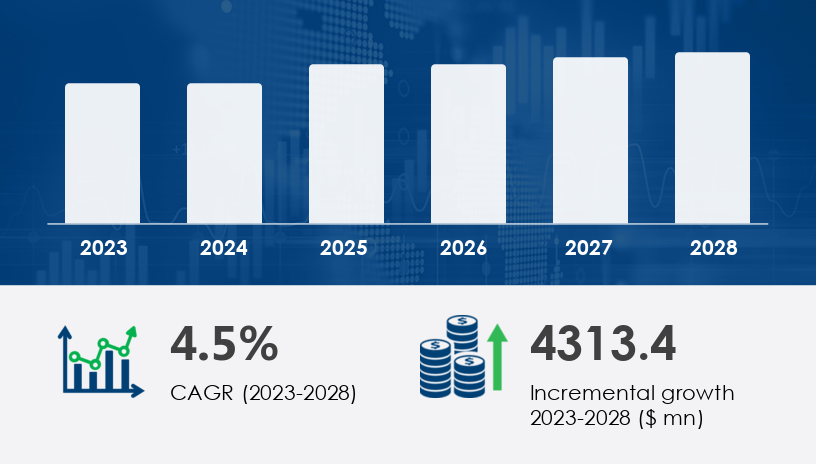The global military multirole aircraft market is projected to expand by USD 4.31 billion between 2023 and 2028, accelerating at a compound annual growth rate (CAGR) of 4.5%. This growth is driven by a confluence of technological advancements, strategic defense priorities, and evolving geopolitical dynamics.
For more details about the industry, get the PDF sample report for free

The Military Multirole Aircraft Market is witnessing steady growth as global defense forces seek advanced platforms that offer superior mission versatility across a wide range of combat scenarios. Prominent aircraft models include the F-35 Lightning, Eurofighter Typhoon, HAL Tejas, JF-17 Thunder, and Su-30 MKI, all designed to perform in roles such as aerial reconnaissance, air interdiction, close air support, and air-to-air combat. These multirole jets incorporate sophisticated technologies such as stealth technology, sensor fusion, and fly-by-wire systems to enhance survivability and lethality. Enhanced payload capacity, increased combat radius, and adaptable weapon bays further enable these aircraft to handle both air-to-ground attacks and suppression defense missions. Platforms like the F/A-18 Hornet and JAS 39 Gripen also support aircraft carrier operations, boosting their appeal for navies and joint force missions. As defense strategies shift toward network-centric warfare, the demand for integrated and adaptable fighter jets continues to rise globally.
Market Growth: Anticipated to reach USD 4.31 billion by 2028, with a CAGR of 4.5%.
Key Drivers: Environmental sustainability, modernization of defense fleets, and increasing geopolitical tensions.
Regional Dynamics: North America leads in market share, while Asia-Pacific exhibits the highest growth potential.
See What’s Inside: Access a Free Sample of Our In-Depth Market Research Report.
Environmental Sustainability: With rising concerns over carbon footprints, military forces are investing in fuel-efficient and low-emission aircraft. For instance, fighter jets consume approximately double the fuel of commercial aircraft, prompting a shift towards more sustainable aviation technologies.
Technological Advancements: The integration of unmanned aerial vehicles (UAVs) and advanced rotorcraft is enhancing operational capabilities. UAVs offer advantages such as increased operational capabilities and reduced risk to human lives.
Geopolitical Tensions: Escalating conflicts and defense modernization programs are driving demand for versatile multirole aircraft capable of performing various missions effectively.
UAV Integration: The increasing adoption of UAVs poses a challenge to traditional manned multirole aircraft, potentially impacting market growth.
Budget Constraints: Defense ministries worldwide face budgetary constraints, making cost-effective solutions crucial for maintaining and expanding aircraft fleets.
Request Your Free Report Sample – Uncover Key Trends & Opportunities Today
Rotorcraft: Estimated to witness significant growth during the forecast period. Rotorcraft, including helicopters and tiltrotor aircraft, provide vertical take-off and landing (VTOL) capabilities, enabling them to operate in challenging terrains and perform tasks such as troop transportation, medical evacuation, reconnaissance, search and rescue, and special operations support.
Fixed-Wing Aircraft: Contribute to air superiority, aerial bombing, electronic warfare, reconnaissance, military exercises, interception, anti-piracy operations, and surveillance and reconnaissance. Military budgets continue to invest in these aircraft to maintain a strong and diverse military aircraft fleet.
The global military multifole aircraft market is segmented into the following regions:
North America: Dominated the market in 2023, with the United States and Canada being significant contributors. Defense forces in this region prioritize the acquisition of multirole aircraft due to increasing global conflicts and threats to civilian safety.
Asia-Pacific: Expected to exhibit the highest growth rate during the forecast period, driven by defense modernization programs in countries like China, India, and South Korea.
Key players in the military multirole aircraft market include:
Lockheed Martin Corp.: Known for its advanced fighter jets and multirole aircraft.
The Boeing Co.: Offers a range of multirole aircraft catering to various defense needs.
Airbus SE: Provides versatile rotorcraft and fixed-wing aircraft solutions.
Eurofighter GmbH: Specializes in multirole combat aircraft with advanced capabilities.
Saab AB: Offers innovative multirole aircraft solutions for modern defense requirements.
Advanced research into the military multirole aircraft segment focuses on upgrading key subsystems such as the avionics system, radar system, and infrared sensors to meet the demands of modern warfare. The inclusion of active radar and passive radar, along with helmet-mounted displays, cockpit displays, and electro-hydrostatic actuators, enhances pilot situational awareness and control. New-generation platforms like the MiG-35 Fighter emphasize super maneuverability, thrust vectoring, and Auto-GCAS (Automatic Ground Collision Avoidance System) for improved flight safety and performance. Integration of artificial intelligence and machine learning is advancing flight control systems, optimizing real-time decision-making in high-threat environments. The use of precision munitions, advanced missile systems, and support for electronic warfare roles illustrates the increasing importance of multi-domain capabilities. Research is also exploring greater fuel efficiency and sustainability for long-range deployments, supporting roles in joint strike operations. Overall, the market reflects a continuous push for innovation to maintain air dominance in increasingly complex combat theaters.
The ongoing Joint Multi-Role (JMR) program aims to integrate rotorcraft and fixed-wing capabilities, influencing military budgets and future defense strategies. Advanced models like the Tupolev T-160 aircraft are setting benchmarks for versatility and power.
Get more details by ordering the complete report
UAV Integration: The increasing adoption of unmanned aerial vehicles (UAVs) for reconnaissance, surveillance, and target acquisition may slightly hinder the growth of the military multirole aircraft market during the forecast period.
Budget Constraints: Defense ministries worldwide face budgetary constraints, making cost-effective solutions crucial for maintaining and expanding aircraft fleets.
Investment in Sustainable Technologies: Prioritize the development and procurement of fuel-efficient and low-emission aircraft to align with environmental sustainability goals.
Focus on Versatility: Invest in multirole aircraft that can perform a wide range of missions, enhancing operational flexibility.
Monitor UAV Developments: Stay abreast of advancements in UAV technology to integrate complementary capabilities into existing aircraft fleets.
The military multirole aircraft market is poised for significant growth, driven by technological advancements, environmental considerations, and evolving defense needs. Stakeholders should focus on sustainable innovation, operational versatility, and strategic integration to capitalize on emerging opportunities.
Safe and Secure SSL Encrypted